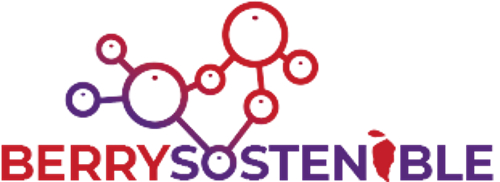
BERRYSOSTENIBLE Operational Group: Sustainable management of fertigation in red berries by integrating profitable digital technologies with participatory methodologies
- Type Operational group
- Status In progress
- Execution 2023 -2025
- Assigned Budget 291.581,54 €
- Scope Autonómico
- Autonomous community Andalucía
- Project website GO BERRYSOSTENIBLE
Results: R2: Document identifying problems to be solved, requirements, and specifications for generating the ICT tool derived from the participatory co-creation workshops. Main practical recommendations: In relation to R2, the participatory co-development advocated by this project is an approach that underpins responsible research and innovation and is a cross-cutting theme in smart strategies such as the European Innovation Partnership on Smart Cities and Communities. This commitment to inclusive processes was realized through a Participatory Workshop where the main threats, opportunities, weaknesses, and strengths were identified. To this end, an effort was made to respect the way ideas were communicated, the language used was colloquial, and the work was carried out in a climate of mutual trust. The analysis was continuous throughout the development of the ICT tool.
Expected results: R3: Generation of predictive irrigation and fertilization models for red fruits based on agronomic models and/or artificial intelligence models. Main practical recommendations: The main advantage of generating predictive irrigation and fertilization models is to improve field action strategies and optimize sensor positioning to obtain a situation as close as possible to the real state of the soil-crop-meteorology-distribution network system. They also allow the detection of anomalies and their communication through alarms. • Irrigation and fertilization strategies: The main advantage of implementing these models is knowing when, where, and with what quantity fertigation is necessary. • Sensor positioning: Optimal sensor positioning seeks to maximize information gain by minimizing the number of sensors needed to obtain an accurate state of the soil-crop-meteorology-distribution network system; consequently, it allows for savings in monitoring costs on the farm. • Anomaly detection or early warning: This allows for the detection of anomalous data in the monitored variables. Anomaly detection is performed online (early warning), allowing users to make real-time decisions to mitigate potential failures.
Expected results: R4: Co-development of an ICT tool that enables optimal water and fertilizer management in Red Fruits, including users/beneficiaries from the beginning of the creation process. Main practical recommendations: The advantages provided by the ICT tool developed in this innovative project are the generation of sustainability indices, such as the Nitrogen Footprint or the Water Footprint, which encourages the use of ICT tools not only to reduce production costs, but also to provide added value to intensive horticultural productions, such as the case of Red Fruits. The implementation of ICT tools in irrigation under the co-creation modality with the end user constitutes a solution to improve the environmental profile of the agricultural sector, in order to convey a message of sustainability and profitability.
Expected results: R5: Disseminate the results of the innovative BerrySostenible project at various levels, from the general public to administrations, irrigation communities, and end-users of ICT tools. Main practical recommendations: For the effective dissemination of the project's conclusions, it is essential to have dissemination agents with a real presence among farmers. In our case, FERAGUA and the Caja Rural del Sur Foundation have extensive experience in disseminating content for the agri-food sector. The implementation of the Dissemination Plan must be a priority in the day-to-day development of the project. A communication strategy must be articulated that contributes to the dissemination, awareness, and visualization of the results among a wide range of target groups, ranging from public administrations (regional, national, and community), the professional irrigation sector (farmers and technicians), the scientific and technical community, environmental and/or rural development entities, and finally, the general public and society.
- A.1. Creation of a network of collaborating farms of the Palos de la Frontera Irrigation Community that allows for the evaluation of the proposed methodology and tools under real-life production conditions.
- A.2. Generation of predictive models that favor the optimization of fertigation management through irrigation recommendations
- A.3. Co-development of an ICT tool that manages data input from the IoT monitoring system, using Big Data techniques, benchmarking, and predictive models (AI).
- A.4. Dissemination of the environmental, agronomic and value-added benefits of sustainable and profitable production using an ICT tool.
In intensive agricultural systems, farmers tend to over-irrigate high-value horticultural crops. Over-irrigation often occurs because most irrigators adopt intuitive or qualitative approaches to scheduling their irrigation, based on past experience rather than data-driven information. In a context of climate change, where rainfall in Andalusia will become increasingly scarce, the area declared as a nitrate-vulnerable zone has increased, and the irrigated area continues to grow, water restrictions and adaptation to the new conditions of water scarcity will be the norm.
Faced with this scenario of restricted water allocations, Irrigation Communities are highly concerned about optimal irrigation and fertilizer management. However, factors such as complex data interpretation, lack of filtering, the absence of alarms, and, ultimately, tools not adapted to end users, have led to a lower level of acceptance of this technology than expected. Therefore, as part of the group created around the innovative BerrySostenible project, we are clear that it is essential to include beneficiaries in the co-generation processes of ICT tools that improve irrigation management through simpler and more intuitive interpretation of the information provided by sensors.
The general objective of the innovative BerrySostenible project is the generation of an ICT tool that allows for sustainable, intelligent, robust and profitable management of the efficient and sustainable use of water and fertilizers in the cultivation of Red Fruits, using participatory methodologies that include the users/beneficiaries of the tool from the beginning of its development.
- R1: Establishment of the Network of Collaborating Farms of the Palos de la Frontera Irrigation Community. Main practical recommendations: Regarding R1, the main added value for the end user is to demonstrate the advantages of a "water user community" becoming an "Open Data Community." This data space, and access to different levels of information grouping, may depend on their level of involvement in providing information, primarily production-related information, which until now has been separate from the information handled by the Irrigation Community and is of an individual nature. Access to comparative data on resource use and productivity by area within a user community is one of the best tools to foster interest in improving their position relative to the community average, so that this desire for continuous improvement contributes to the environmental and economic sustainability of agricultural production. Likewise, the BerrySostenible project proposal contributes to the democratization of access to digital technology.
- R2: Document identifying the problems to be solved, requirements, and specifications for generating the ICT tool derived from the participatory co-creation workshops. Main practical recommendations: In relation to R2, the participatory co-development advocated by this project is an approach that underpins responsible research and innovation and is a cross-cutting theme in smart strategies such as the European Innovation Partnership on Smart Cities and Communities. This commitment to inclusive processes was realized through a Participatory Workshop where the main threats, opportunities, weaknesses, and strengths were identified. To this end, efforts were made to respect the way ideas were communicated, the language used was colloquial, and the work was carried out in a climate of mutual trust. The analysis was continuous throughout the development of the ICT tool.
- Expected results: R3: Generation of predictive irrigation and fertilization models for red fruits based on agronomic models and/or artificial intelligence models. Main practical recommendations: The main advantage of generating predictive irrigation and fertilization models is to improve field strategies and optimize sensor positioning to obtain a situation as close as possible to the actual state of the soil-crop-meteorology-distribution network system. They also allow the detection of anomalies and their communication through alarms. Irrigation and fertilization strategies: The main advantage of implementing these models is knowing when, where, and with what quantity fertigation is necessary. Sensor positioning: Optimal sensor positioning seeks to maximize information gain by minimizing the number of sensors needed to obtain an accurate state of the soil-crop-meteorology-distribution network system; consequently, it saves monitoring costs on the farm. Anomaly detection or early warning: Allows the detection of anomalous data in the monitored variables. Anomaly detection will be performed online (early warning), allowing users to make real-time decisions to mitigate potential failures.
- Expected results: R4: Co-development of an ICT tool that enables optimal water and fertilizer management in Red Fruits, including users/beneficiaries from the beginning of the creation process. Main practical recommendations: The advantages provided by the ICT tool developed in this innovative project are the generation of sustainability indices, such as the Nitrogen Footprint or the Water Footprint, which encourages the use of ICT tools not only to reduce production costs, but also to provide added value to intensive horticultural productions, such as the case of Red Fruits. The implementation of ICT tools in irrigation under the co-creation modality with the end user constitutes a solution to improve the environmental profile of the agricultural sector, in order to convey a message of sustainability and profitability.
- Expected results: R5: Disseminate the results of the innovative BerrySostenible project at various levels, from the general public to administrations, irrigation communities, and end-users of ICT tools. Main practical recommendations: For the effective dissemination of the project's conclusions, it is essential to have dissemination agents with a real presence among farmers. In our case, FERAGUA and the Caja Rural del Sur Foundation have extensive experience in disseminating content for the agri-food sector. The implementation of the Dissemination Plan must be a priority in the day-to-day development of the project. A communication strategy must be articulated that contributes to the dissemination, awareness, and visualization of the results among a wide range of target groups, ranging from public administrations (regional, national, and community), the professional irrigation sector (farmers and technicians), the scientific and technical community, environmental and/or rural development entities, and finally, the general public and society.
- Name of coordinator/entity: Palos de la Frontera Irrigation Community
- Postal address: Travesía San Jorge, 159, Palos de la Frontera, Huelva, 21810
- Coordinator/entity email: crpalos@crpalos.com
- Telephone: 959531073
- Comunidad de regantes Palos de la Frontera
- Comunidad de regantes Palos de la Frontera (crpalos@crpalos.com)
- Universidad de Sevilla (dgutierrezreina@us.es)
- Agroair Technology S.L. (info@agroair.es)
- Asociación FERAGUA de CC.RR. De Andalucía (fca@feragua.com)
- Fundación Caja Rural del Sur (fundacionrrss@crsur.es)
- Comunidad de regantes Palos de la Frontera







